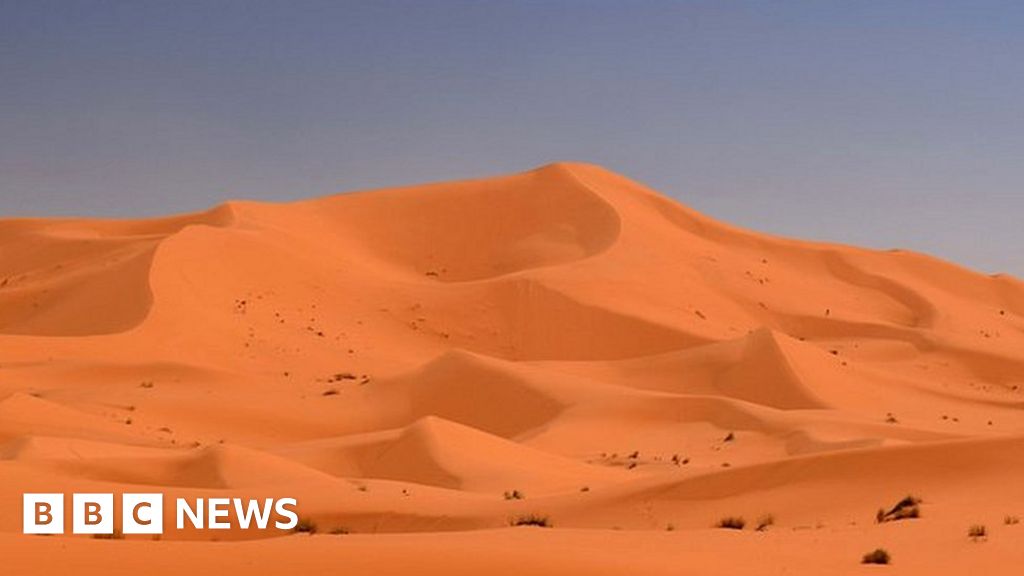C BristowBy Georgina RannardScience reporter The age of one of Earth’s largest and most complex types of sand dune has been calculated for the first time.Star dunes – or pyramid dunes – are named after their distinctive shapes and reach hundreds of metres in height.They are found in Africa, Asia and North America, as well as on Mars – but experts had never before been able to put a date on when they were formed.Now scientists have discovered that a dune called Lala Lallia in Morocco formed 13,000 years ago.Star dunes are created by opposing winds that change direction. Understanding their age helps scientists understand those winds and unpick the climate of that era, says Prof Geoff Duller at the University of Aberystwyth, who published the research with Prof Charles Bristow at Birkbeck University.Lala Lallia (an indigenous Amazigh name meaning highest sacred point) is located in the Erg Chebbi sand sea in south-east Morocco. It is 100m high and 700m wide with radiating arms.After its initial formation, it stopped growing for about 8,000 years and then quickly expanded in the past several thousand years.Normally deserts can be identified in Earth’s geological history, but star dunes were absent until now.Prof Duller says this may be because they are so large that experts did not realise they were looking at one distinct dune. “These findings will probably surprise a lot of people as we can see how quickly this enormous dune formed, and that it is moving across the desert at about 50cm a year,” he adds.The scientists used a technique called luminescence dating to work out the age of the star dune. C BristowThe method calculates when the grains of sand were last exposed to daylight.Samples of sand were taken in the dark from Morocco and analysed in a lab in dim red light conditions similar to an old-fashioned photography workshop.Prof Duller describes the mineral grains in the sand as “little rechargeable batteries”. They store energy within the crystals that comes from radioactivity in the natural environment.Half-million-year-old wooden structure unearthedMystery sea creature discovered in UK waters The longer the sand is buried under ground, the more radioactivity it is exposed to and the more energy it builds up. When the grains are exposed in the lab, they release the energy in light form and scientists can calculate their age.”In our dark laboratory, we see light from these sand grains. The brighter the light then the older the sediment grains and the longer it is since they’ve been buried,” says Prof Duller.Other examples of these huge dunes include Star Dune in Colorado, North America, which is the joint-highest dune in the US, measuring 225m from base to top.Climbing these dunes is hard work, Prof Duller explains. “As you climb, you go up two and slide back one. But it’s worth it – they’re absolutely beautiful from the top,” he says.Related TopicsAberystwythAfricaMorocco …
Article Attribution | Read More at Article Source
[mwai_chat context=”Let’s have a discussion about this article:nn C BristowBy Georgina RannardScience reporter The age of one of Earth’s largest and most complex types of sand dune has been calculated for the first time.Star dunes – or pyramid dunes – are named after their distinctive shapes and reach hundreds of metres in height.They are found in Africa, Asia and North America, as well as on Mars – but experts had never before been able to put a date on when they were formed.Now scientists have discovered that a dune called Lala Lallia in Morocco formed 13,000 years ago.Star dunes are created by opposing winds that change direction. Understanding their age helps scientists understand those winds and unpick the climate of that era, says Prof Geoff Duller at the University of Aberystwyth, who published the research with Prof Charles Bristow at Birkbeck University.Lala Lallia (an indigenous Amazigh name meaning highest sacred point) is located in the Erg Chebbi sand sea in south-east Morocco. It is 100m high and 700m wide with radiating arms.After its initial formation, it stopped growing for about 8,000 years and then quickly expanded in the past several thousand years.Normally deserts can be identified in Earth’s geological history, but star dunes were absent until now.Prof Duller says this may be because they are so large that experts did not realise they were looking at one distinct dune. “These findings will probably surprise a lot of people as we can see how quickly this enormous dune formed, and that it is moving across the desert at about 50cm a year,” he adds.The scientists used a technique called luminescence dating to work out the age of the star dune. C BristowThe method calculates when the grains of sand were last exposed to daylight.Samples of sand were taken in the dark from Morocco and analysed in a lab in dim red light conditions similar to an old-fashioned photography workshop.Prof Duller describes the mineral grains in the sand as “little rechargeable batteries”. They store energy within the crystals that comes from radioactivity in the natural environment.Half-million-year-old wooden structure unearthedMystery sea creature discovered in UK waters The longer the sand is buried under ground, the more radioactivity it is exposed to and the more energy it builds up. When the grains are exposed in the lab, they release the energy in light form and scientists can calculate their age.”In our dark laboratory, we see light from these sand grains. The brighter the light then the older the sediment grains and the longer it is since they’ve been buried,” says Prof Duller.Other examples of these huge dunes include Star Dune in Colorado, North America, which is the joint-highest dune in the US, measuring 225m from base to top.Climbing these dunes is hard work, Prof Duller explains. “As you climb, you go up two and slide back one. But it’s worth it – they’re absolutely beautiful from the top,” he says.Related TopicsAberystwythAfricaMorocco …nnDiscussion:nn” ai_name=”RocketNews AI: ” start_sentence=”Can I tell you more about this article?” text_input_placeholder=”Type ‘Yes'”]

